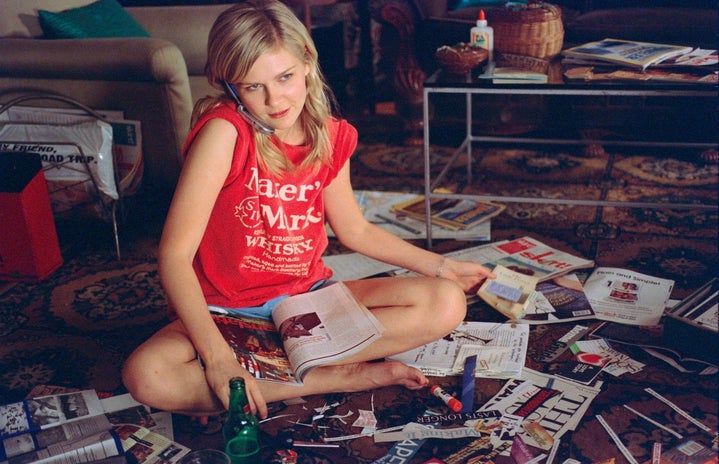The term “Manic Pixie Dream Girl” was created by the culture writer Nathan Rabin, in an analysis of the movie Elizabethtown (2005). According to him, Manic Pixie Dream Girls are those female characters who answer the beauty stereotypes, but in a peculiar way. They are intelligent and funny, strong and impulsive, but at the same time, a little awkward and lonely.
This uncommon mix of features is what attracts the male protagonist, who sees the Manic Pixie Dream Girl as someone who helps him reach his ambitions and accomplish his dreams. Actually, is her only function in the plot. She has no desires, no ambitions, no independent life, only being there to support the hero, who is normally going through some kind of crisis, to overcome this bad situation and feel happy again. To make it clearer, let’s see some examples:
- Elizabethtown (2005)
-
In Elizabethtown, Drew Baylor (Orlando Bloom) is a shoe designer who had failed in a very important project at his workplace and was fired. He is about to commit suicide when he is warned that his father has died. So, he goes on a trip to Kentucky, where his father will be buried, and, on the plane, he gets to know Claire (Kristen Dunst), a flight attendant. Across the movie, Drew’s conflicts and emotions are explored, but Claire seems to have no feelings that are not related to him.
- (500) Days of Summer (2009)
-
Another famous example is (500) Days of Summer (2009). The movie shows the romance between Summer Finn (Zooey Deschanel) and Tom Hansen (Joseph Gordon-Levitt). Tom is an idealistic man who meets Summer, a girl who is beautiful, intelligent and cute. During the story, Summer goes from perfect girlfriend to stone-hearted woman. After she breaks up with him, Tom realizes that their relationship helped him understand his own feelings. However, the spectators know very few about Summer’s experiences, desires and emotions.
- Garden State (2004)
-
Even though the term was created in 2007, movies that came before already used that trope. In Garden State (2004), Sam, Natalie’s Portman character, can be considered a Manic Pixie Dream Girl. The plot tells the story of Andrew Largeman (Zach Braff), an incipient actor who has trouble with heavy medicines and needs to come back to his birth city when his mother dies. There, he meets Sam, a joyful, fancy and kind girl. By staying with her, he finds a new meaning for his life. Sam is there to be the catalyser of Andrew’s transformation and her conflicts almost are not explored.
- Always summer, never winter
-
The problem of the Manic Pixie Dream Girl is that she is always in the service of the male protagonist. She is silly, sketchy and childish, has no feelings, no desires, no inner life. She is there to save him and if her emotions are addressed, it is done in a superficial way, only to make the man’s journey bigger. So, using this trope fortifies the gender stereotype that women are less important, less complex and even less human than men.
The Manic Dream Pixie Girl helps to romanticize the control of women’s body and thoughts. The MPDG is beautiful and pure and has no problems with her sexual life. She also has a mystic knowledge of life and a strong desire to teach it to the male protagonist, who does not need to understand her feelings or motivations. All these traits put her in a non-human position, reinforcing the idea, coined by Simone de Beauvoir, that women are the “other of man” and because of that, must be kept in a passive position.
- Mislead representation
-
This type of character also creates a dangerous point of view of femininity. Somehow, MDPGs challenge the classical stereotype of women, because they use peculiar clothes, are intelligent, funny and lonely. To summarize, they are the opposite of the High School popular girl. However, they still are attractive to men. The trope is transmitting the idea that women can be different, since this “different” is interesting to boys. Their identity and their development are wiped out, because they are always seen through the male gaze.
Knowing this kind of character on the screen or even in books, male spectators and readers can create the idea that they must find a girl who will always be there to reach their expectations, independently of her own thoughts. Even worse, girls might see the MPDG as a model to be what boys expect. And, as it happens on movies and books, they will help to write men’s stories, forgetting to write their own.
One of the reasons that explains the presence of the MPDG stereotype is the lack of women participation in the movie industry. The unreal magic girl who shows up in the right moment to save the protagonist is, normally, designed by male writers, who, in spite of their potential to create great characters and plots, are not familiarised with the difficulties, peculiarities and non-stereotyped attributes of being a woman.
- A prism, not a glass
-
In 2014, Nathan Rabin, the same person who invented the name “Manic Dream Pixie Girl”, wrote an essay apologizing for doing that. According to him, the MDPG is an archetype that has always existed, but giving it a name and putting characters into this definition, including the ones who are cultural icons and worldwide beloved, is a reductive attitude, intensified by the exhaustive and inappropriate use of this term.
Trying to match women with an already-made set of qualities and characteristics is a sexist act by itself. Just because a woman participates in the development of a male character, it does not mean that she is necessarily a Manic Pixie Dream Girl. Summer, from (500) Days of Summer, for example, has been considered the personification of these trope. However, recently, this statement was questioned. The movie chooses to show Tom’s point of view and this is clear since the beginning of the plot. So, it can be seen as a criticism and not as enforcement of misogynist stereotypes. As Tom’s sister says, because a girl likes the same odd things that he does, it does not mean that she is the woman of his life.
- Back in the past
-
Another polemic character is Holly Golightly, from Breakfast at Tiffany’s (1961). She has some features of the MPDG. She is joyful, impulsive, a little childish and turns upside down the life of a guy, helping him to mature his feelings and go through new emotions. Nevertheless, Holly’s previous experiences, emotions and conflicts are shown and explored in the plot. The same happens to Maria von Trapp (Julie Andrews), from The Sound of Music (1965). It is true that Maria is optimistic, kind and teaches Captain von Trapp (Christopher Plummer) to love again. However, her doubts and fears are addressed during the story.
Movie and book characters are essential for those who watch or read them. Inside the screen and between the paper pages, there is a sacred world, in which readers and spectators learn about their own personality and feelings. More than looking for stereotypes to describe the characters, it is important to understand them taking in account the internal context of the plot and external variables, such as the time and the place in which the story was created. Recognizing tropes are important, but only if we try to subvert them.
—————————————————————–
The article above was edited by Mel Trench.
Liked this type of content? Check Her Campus Casper Libero home page for more!


